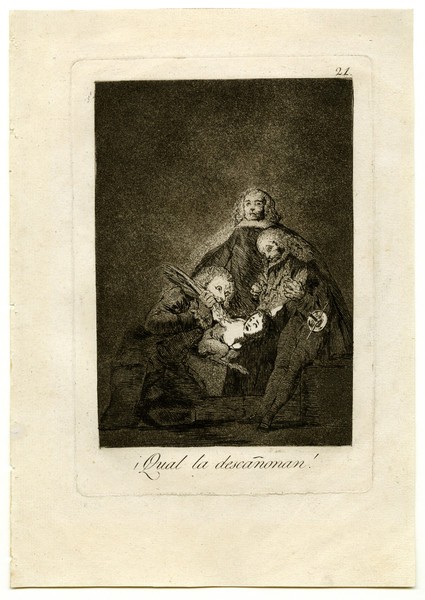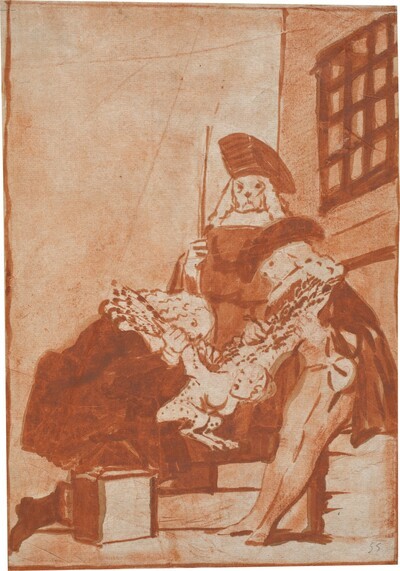- Cronología
- Ca. 1797 - 1799
- Dimensiones
- 218 x 149 mm
- Técnica y soporte
- Etching and burnished aquatint
- Reconocimiento de la autoría de Goya
- Undisputed work
- Ficha: realización/revisión
- 29 Nov 2010 / 29 May 2024
- Inventario
- 225
Which one do they unchain it! (in the lower part)
21. (in the upper right-hand corner)
See Francisco de Goya y Lucientes, Painter.
There is a state proof with the full title in manuscript.
In the first proofs of the print run, the "ñ" appears without a tilde until the letter engraver corrected the error.
A preparatory drawing of this engraving has survived.
A bird-woman is attacked by a clerk and a bailiff, all of them with the face of a cat. This animal was defined in the dictionary of the Spanish language published in the 18th century as "the thieving thief who steals with cunning and deceit". The scene is being watched by a magistrate who sees how one of the men violently grabs the woman by the wing, which he bites off, causing the young woman to wince. Everything is taking place against a neutral background with no spatial reference.
Goya makes extensive use of a very grainy aquatint to create the neutral background in which he has suggested a certain luminosity around the figures. The white of the woman's torso and face, as well as the white of the hilt of the bailiff's sword, is obtained with a reserve of varnish.
The three manuscripts that explain the engravings of the Caprices series coincide in their interpretation of this engraving, which shows the complicity between the judges and the bailiffs and scribes in "fleecing" the prostitutes. Goya continues with the theme of engravings no. 19 and 20, in which the prostitutes took advantage of their clients' base instincts to extract money from them, although in this case he balances the scales by making them the victims of their clients. This way of establishing a parallel between two situations to demonstrate the parity between them is reminiscent of the way Goya censures violence in all its forms in engravings no. 2 and 3 of The Disasters of War (Rightly or Wrongly ; The Same Thing ), without taking a position in favour of one or the other.
The bailiffs sometimes pursued prostitutes and extorted money from them, thus obtaining multiple benefits. Paradoxically, however, they were precisely the ones who were informed of the places where this trade was practised and gave directions to the brothels to all those who came from outside Madrid and wanted this type of service.
In The Art of Whores by Nicolás Fernández de Moratín (Madrid, 1737-1780) - a regular at the gathering at the Fonda de San Sebastián attended by José Cadalso (Cádiz, 1741-San Roque, Cádiz, 1782), Tomas de Iriarte (Puerto de la Cruz, Tenerife, 1750-Madrid, 1791) and Ignacio López de Ayala (Cádiz, 1745/1750-1789) - a space is devoted to the bailiffs. On p. 81, the following is said: "Everyone knows what perverse people the bailiffs and notaries are; they persecute the poor whores, not with the desire to extinguish the bad, because they eat with crimes, and their life hangs on lawless men, criminals, and holy virtue is their murderer; and although they know that swindling them is not the way to correct them, since they remain poor, they always go on whoring them, robbing them with the pretence of making amends". Likewise, in Quevedo's The Sheriff Bailiff, the author refers to the prevailing corruption in the sphere of justice: "(...) the Judges are our pheasants, our gift dishes, and the seed that gives us devils the most profit and fruit; because from every Judge we sow, we take six Procurators, two Rapporteurs, four Scribes, five Letrados, and five thousand Negociantes, and this every day. From each Notary we take twenty Officers, and from each Officer thirty Bailiffs, and from each Bailiff ten Bailiffs".
The plate is preserved in the National Chalcography (no. 192).
-
Goya. Gemälde Zeichnungen. Graphik. TapisserienKunsthalle BaselBasle1953from January 23th to April 12th 1953cat. 211
-
Goya. Das Zeitalter der Revolucionen. Kunst um 1800 (1980 – 1981)Hamburger KunsthalleHamburg1980cat. 27
-
Goya y el espíritu de la IlustraciónMuseo Nacional del PradoMadrid1988from October 6th to December 18th 1988. Exhibited also at Museum of Fine Arts, Boston, January 18th to March 26th 1989; The Metropolitan Museum of Art, Nueva York, May 9th to July 16th 1989, Madrid curator Manuela B. Mena Marqués, scientific directors Alfonso E. Pérez Sánchez and Eleanor A. Sayrecat. 45
-
Goya. La década de Los CaprichosMadrid1992organized by Real Academia de Bellas Artes de San Fernando sponsored by Fundación Central Hispano, Madrid, consultant editor Nigel Glendinnig. From October 26th 1992 to January 10th 1993cat. 91
-
Francisco de GoyaMuseo d'Arte ModernaLugano1996exhibition celebrated from September 22nd to November 17th.cat. 21, p.48
-
Francisco Goya. Sein leben im spiegel der graphik. Fuendetodos 1746-1828 Bordeaux. 1746-1996Galerie KornfeldBern1996from November 21st 1996 to January 1997cat. 27
-
Goya e la tradizione italianaFondazione Magnani RoccaMamiano di Traversetolo (Parma)2006consultant editors Fred Licht and Simona Tosini Pizzetti. From September 9th to December 3th 2006cat. 21, p.151
-
Goya. Opera graficaPinacoteca del Castello di San GiorgioLegnano2006exhibition celebrated from December 16th 2006 to April 1st 2007p.28
-
Goya e ItaliaMuseo de ZaragozaZaragoza2008organized by the Fundación Goya en Aragóna, consultant editor Joan Sureda Pons. From June 1st to September 15th 2008cat. 322
-
Goya et la modernitéPinacothèque de ParisParís2013from October 11st 2013 to March 16th 2014cat. 186
-
Hamburg2019cat. 100
-
2022
-
Goya engravings and lithographs, vol. I y II.OxfordBruno Cassirer1964p.90, cat. 55
-
Vie et ouvre de Francisco de GoyaParísOffice du livre1970p.179, cat. 494
-
Goya, la década de los caprichos: dibujos y aguafuertesMadridReal Academia de Bellas Artes de San Fernando1992cat. 90-91
-
Catálogo de las estampas de Goya en la Biblioteca NacionalMadridMinisterio de Educación y Cultura, Biblioteca Nacional1996p.84, cat. 109
-
El libro de los caprichos: dos siglos de interpretaciones (1799-1999). Catálogo de los dibujos, pruebas de estado, láminas de cobre y estampas de la primera ediciónMadridMuseo Nacional del Prado1999pp. 148-151
-
ParísPinacoteca de París2013p. 252
-
Goya. In the Norton Simon MuseumPasadenaNorton Simon Museum2016pp. 42-75
-
HamburgHirmer2019p. 310
-
Museo de Bellas Artes de Badajoz y Diputación de Badajoz2022p. 36

